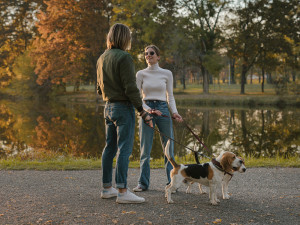How Often Should a Dog Pee? Find Out What’s Healthy
Everything you need to know about your dog’s pee habits.
In This Article:
How Much Should Dogs Pee? When to See a Vet For Frequent Or Excessive Urination Reasons Why Your Dog May Be Peeing a Lot Treatment For Excessive Peeing In Dogs Tips for Regulating Your Dog’s Pee Schedule Bottom Line
If you’ve ever walked your pup for what felt like hours while they sniffed every tree without doing their business, you’ve probably wondered, How often should a dog actually pee? On the flip side, maybe your pup has suddenly become a canine fountain, and you wonder if you should feel concerned.
The average adult dog pees three to fiveopens in new tab times daily, depending on size, hydration, health, and age. However, while this range gives a general idea of what’s “normal,” peeing habits vary across dog breeds and life stages. What matters most is your dog’s baseline. Once you know what’s typical for them, you’ll be quicker to spot when something is off.
How much should dogs pee?
The answer depends on the dog’s size, age, bladder capacity, and health. Other factors, such as weather and time of day, could also make a subtle difference. Some pups are pee-once-and-done types, while others treat every tree like it’s got a stamp-your-passport policy.
How much do you spend on your pet per year?
Here's how it generally breaks down:
Adult dogs
Adult dogs typically pee three to five times daily. However, factors such as hydration, nutrition (especially if they’re on wet food), and activity level play roles. Dogs who drink more water than usual or are highly active must pee more often.
Well-trained adult dogs can hold their urine longer if necessary. However, regularly holding it for more than eight to 10 hours can be damaging, increasing the likelihood of urinary tract infections or bladder issues, even in healthy adult dogs.
Puppies
Puppies are walking bladders — tiny, adorable, leaky bladders. A general rule of thumb: Puppies can hold their pee for one hour per month of age, up to six months. So, a three-month-old pup may need to go every three hours. However, frequency can also be affected by play, meal times, and naps, because most puppies need a potty break after they’ve slept.
Nighttime is a different story. Some puppies can sleep for hours but still need at least one pee break in the wee hours (pun intended).
Senior dogs
Older dogs, especially those seven years and up, may need to go more frequently, particularly if they have age-related health conditions, like kidney issues or the early stages of incontinence. They may have a more challenging time holding their urine overnight.
If you’re finding more “oops” puddles around the house, it may be a normal part of aging. However, a vet checkup can confirm if you should be concerned.
When to see a vet for frequent or excessive urination
If your dog suddenly goes from three bathroom trips daily to a dozen or more, it’s a sign that something’s wrong. Frequent urination, also known as polyuria, can be a sign of underlying health problems, including:
Diabetes
Kidney disease
Liver issues
Urinary tract infections (UTIs)
Cushing’s disease
Bladder stones
Any sudden or unexplained increase in urination frequency, especially when paired with lethargy, excessive thirst, or “accidents” indoors, is worth a vet visit. And while we’re on the topic, if your dog is straining to pee, whining while urinating, or only producing tiny drops (pollakiuria), that’s another red flag. This behavior could indicate an infection.
How vets evaluate excessive urination
When you take your dog to the vet for excessive peeing, the visit may start with questions like:
How long has this been happening?
Has your dog been drinking more water than usual?
Are they eating normally?
Have you noticed any indoor accidents or behavior changes?
Your vet may perform urinalysis (a urine test), bloodwork, or imaging like X-rays or ultrasounds to discover the cause.
Tip: Bring a fresh sample of your dog’s urine to your appointment. It saves time and helps your vet begin investigating possible health conditions. Use a clean container and collect it directly before the visit.
Reasons why your dog may be peeing a lot
There are a few reasons why your dog may be peeing a lot, including:
Medical conditions
Urinary tract infections, kidney diseases, diabetes, and hormonal imbalances (like Cushing’s) can cause increased urination. These conditions may cause your dog to drink more water, naturally leading to more peeing.
Polyuria
Polyuria is the scientific term for producing more urine than usual. It’s typically linked to increased water intake or a reduced ability of the kidneys to concentrate urine. Polyuria often goes hand-in-hand with polydipsia (excessive thirst).
If your dog empties their water bowl faster than expected and asks to go outside more often, this is a pattern your vet needs to know about.
Pollakiuria
Pollakiuria is frequent urination in small amounts, usually a symptom of bladder inflammation or infection. Dogs with pollakiuria may squat to pee repeatedly during walks or struggle to empty their bladder fully, but only a few dribbles come out.
This is common with UTIs or bladder stones and may be accompanied by blood in the urine or apparent discomfort. Don’t ignore the symptoms. Pollakiuria needs immediate medical attention.
Treatment for excessive peeing in dogs
Treatment depends on the cause. UTIs may require antibiotics and time to heal, but more serious conditions, like diabetes or kidney disease, may require a long-term care plan. The latter would include medications and dietary changes.
Suppose anxiety or behavioral factors are behind your dog’s frequent urination (yes, stress can trigger frequent urination). According to Dr. Karen Overall, a board-certified veterinary behaviorist in Pennsylvania, increased urination in dogs may reflect anxiety, especially if accidents happen primarily when the dog is left alone or during stressful events. In that case, your vet may recommend calming supplements, behavior training, or changes to your pup’s routine.
Whatever the issue, early intervention is essential. The sooner you catch the problem, the easier it will be to treat or manage, leading to a happier, healthier dog.
Tips for regulating your dog’s pee schedule
Stick to a routine. Dogs thrive on predictability. Regular pee breaks help reinforce good habits, so take your pup outside in the morning, after meals, and before bed.
Track their schedule. Use a note on your phone or a dog care app to monitor how often your dog pees. If things suddenly change, you’ll know sooner.
Don’t ignore “the signal” or “the potty dance.” Respond quickly if your dog heads to the door or starts circling and whining at you. Delayed bathroom breaks can lead to bladder strain, kidney damage, and accidents.
Hydration matters. Your dog needs constant access to clean, fresh water. Dehydration can lead to urinary tract issues and crystal formation (a precursor to bladder stones and infections).
Regular checkups. Routine vet visits can catch issues before they become serious, especially for senior dogs.
Bottom line
So, how often should a dog pee? To summarize, healthy adult dogs pee three to five times daily, while puppies and seniors need to go more often. Dogs who eat wet food and drink more water will also naturally urinate more. Knowing what’s normal for your dog and watching for sudden changes are key.
Frequent peeing can be harmless sometimes, especially if your dog drinks more water, or it can indicate something unhealthy. If your dog’s peeing habits change suddenly, trust your gut and talk to your vet.
Don’t be shy about asking questions or monitoring new patterns. Your dog depends on you to help them feel their best, ensuring their bathroom habits stay on track.
References
Dec 02, Harriet Meyers Published:, et al. “Why Is My Dog Peeing so Much? Urinary Frequency in Dogs.” American Kennel Club, www.akc.org/expert-advice/health/why-is-my-dog-peeing-so-much-urinary-frequency/opens in new tab.
Horn, Lovelia. "How Often Do Dogs Need to Pee." Every Creature Counts, 24 Apr. 2022, www.everycreaturecounts.org/how-often-do-dogs-need-to-pee/opens in new tab
Overall, Karen L. Clinical Behavioral Medicine for Small Animals. Mosby, 1997. https://archive.org/details/clinicalbehavior0000overopens in new tab











